

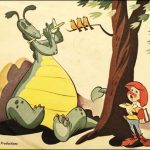
To note, I am not an expert on music theory or history of music from this period, and as such, this article will be more casual in its analysis. I invite anyone in the comments to provide insights about the song arrangements, especially production and release information.
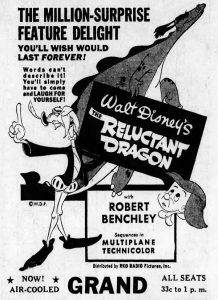 Now, for this article, I am not the first writer on Cartoon Research to discuss these recordings. Greg Ehbar wrote Disney’s “The Reluctant Dragon” – on Records (2016) which examined in depth the All About Dragons (1966) album. Then James Parten’s article Not So Reluctant (2018) focused on select recordings from the 1940s. In this post I’ll be covering the recordings they mentioned and then some. However, there still may be some versions missing due to a song’s unavailability online, or the cover was so obscure it wasn’t on my radar. Additionally, I will note at the end of each song notable lyrical differences. For the primary lyrics, please refer to the third article in this series. To identify the characters, “N” refers to the Narrator, “D” refers to the Dragon, and the number after refers to verse number. For example, N3 is the Narrator’s 3rd verse.
Now, for this article, I am not the first writer on Cartoon Research to discuss these recordings. Greg Ehbar wrote Disney’s “The Reluctant Dragon” – on Records (2016) which examined in depth the All About Dragons (1966) album. Then James Parten’s article Not So Reluctant (2018) focused on select recordings from the 1940s. In this post I’ll be covering the recordings they mentioned and then some. However, there still may be some versions missing due to a song’s unavailability online, or the cover was so obscure it wasn’t on my radar. Additionally, I will note at the end of each song notable lyrical differences. For the primary lyrics, please refer to the third article in this series. To identify the characters, “N” refers to the Narrator, “D” refers to the Dragon, and the number after refers to verse number. For example, N3 is the Narrator’s 3rd verse.
The Reluctant Dragon
Vocalists – Maury Cross, George Gingell
Swing and Sway with Sammy Kaye (1941)
For technical information regarding this recording, I shall refer to the website, Discography of American Historical Recordings (DAHR). This site will also be my main source of information for the versions released by Richard Himber and His Orchestra and King’s Men.
According to DAHR, Sammy Kaye’s recording is the earliest recorded version of the song, with two takes documented on 5/23/1941 in New York, New York. There are two credited singers on the record, one playing the dragon, Maury Cross – who is directly credited on the record – and George Gingell, who I’m inferring voiced the narrator.
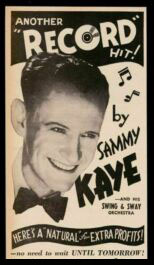 As the earliest recorded version of the song, I feel it starts these covers off to a strong start, and compared to other covers from 1941, I prefer Cross’ overall interpretation of the character. However, I consider this version the most … aggressively flamboyant of the covers released in 1941. Even if one doesn’t pay close attention to the lyrics, the way the dragon is portrayed makes it quite evident—especially in these earlier recordings—how one should interpret the character, with the singer typically portraying him with an exaggerated falsetto, to arguably varying degrees of enjoyability.
As the earliest recorded version of the song, I feel it starts these covers off to a strong start, and compared to other covers from 1941, I prefer Cross’ overall interpretation of the character. However, I consider this version the most … aggressively flamboyant of the covers released in 1941. Even if one doesn’t pay close attention to the lyrics, the way the dragon is portrayed makes it quite evident—especially in these earlier recordings—how one should interpret the character, with the singer typically portraying him with an exaggerated falsetto, to arguably varying degrees of enjoyability.
As noted by Parten in his article More Cartoon Music – For Radio Only (2018), NBC Thesaurus recorded a cover of the song, which is currently not available to listen to online. However, he notes NBC Thesaurus used “the same band that had recorded it for the Victor: Swing and Sway with Sammy Kaye. The same vocalists were used, and it’s probably difficult to tell one version from another.” I agree with Parten’s theory that the two versions likely sound the same, though I still hope a recording surfaces online.
Lyric changes:
The verse order is switched slightly, with N3 sung directly after N2. The remaining verse order consists of D2, N4, and D3. The last verse, D4, is removed entirely.
Reluctant Dragon
Vocalists – Harry Stanton and The Joseph Lilly Ensemble
Richard Himber And His Orchestra (1941)
While location restricted on YouTube, those living outside of America can listen to a higher quality recording here.
Recorded in Los Angeles on June 26, 1941, this version captures the “bright jump tempo” described on some of the sheet music quite well, and is arguably one of the strongest arrangements among the versions that year. Of all the recordings from this year, this version is the one I prefer to listen to on repeat, but more so for the orchestration than the vocalist.
As with other performers from this period, the vocalist for the dragon sings in an effeminate manner. However, in comparison to other covers from this period, it’s a more restrained characterization of the dragon’s voice. Overall, feeling like a safe—albeit forgettable at times—interpretation, and one I would recommend to those who prefer a less overtly offensive portrayal of the character.
Lyric changes:
Due to a lengthened instrumental opening and interlude, N3 and N4 are removed entirely, while D3 and D4 are greatly shortened to include only the last three lyrics.
There’s an additional, final spoken line in which the dragon concludes the song in a goofy, bashful-esque voice: “Yah, I sure am reluctant I am.”
Reluctant Dragon
King’s Men (1941)
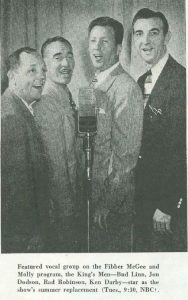 Another restrained cover, in part because the orchestration is significantly simpler than in other versions from this period. While the King’s Men are a wonderful quartet—especially when performing as a group—the solo performances could have been given a stronger arrangement. In this version, the narrator is performed by the quartet, while the dragon is portrayed by two different singers, one performing low and the other high. Personally, of the two ranges, I prefer the falsetto-like interpretation. The switch between the two different variations—especially when the dragon has a call and response with himself—becomes a bit jarring.
Another restrained cover, in part because the orchestration is significantly simpler than in other versions from this period. While the King’s Men are a wonderful quartet—especially when performing as a group—the solo performances could have been given a stronger arrangement. In this version, the narrator is performed by the quartet, while the dragon is portrayed by two different singers, one performing low and the other high. Personally, of the two ranges, I prefer the falsetto-like interpretation. The switch between the two different variations—especially when the dragon has a call and response with himself—becomes a bit jarring.
Interestingly, the King’s Men performed the song on the Fibber McGee and Molly radio show. Since the King’s Men had previously appeared in some of Disney’s shorts and features, it makes me wonder if Disney specifically sought them out for these radio broadcasts. From what I can tell, the one available on YouTube is from the King’s Men’s second appearance on the show on June 24, 1941. Given that The Reluctant Dragon was released on June 27th, I assume their first performance was either earlier that month or sometime in May.
While there are minor differences in the opening and ending orchestration and in how a word is pronounced, the studio and live versions are fairly identical. Regarding when these performances occurred in relation to the release of the studio version, I’m not sure. DAHR lists they recorded in studio on June 28, 1941, which, if accurate, means the shellac was released after both the film and their radio appearances.
Lyric changes:
For this section, I will just compare the studio recording and not the live version.
The changes range from minor switches in lyric order within N2, to major ones with N3, N4, and D3 removed entirely. This version also includes some new verses for D2 and D4. While Charles Wolcott, Ed Penner, and T. Hee are credited for the lyrics, I can’t confirm if they wrote them. A quick note: there’s one line in D3 that is incredibly tough to make out clearly, and I have noted it as indistinguishable. I believe “19, elevendy,” and “BC” are sung, but I would be interested in other listeners’ suggestions.
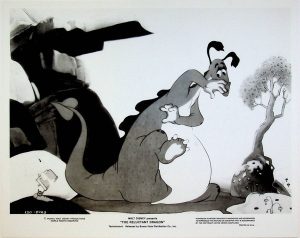 D2– I’m THE RELUCTANT DRAGON. That’s me, carefree!
D2– I’m THE RELUCTANT DRAGON. That’s me, carefree!
I’m THE RELUCTANT DRAGON since (indistinguishable). Could be!
They call the timid Dragon
What rot! I’m not!
When others fight, I run away
I guess that I was born that way,
I’m to be Queen of the May today
D4– I’m THE RELUCTANT DRAGON.
I’m frail and pale
The awful reluctant Dragon.
Don’t step on my tail!
They call me the timid Dragon
What rot! I’m not!
I just won’t fight; I’d rather play. I know I shan’t get hurt that way
Here we go gathering nuts in May. I’m so reluctant. Wooo.
To me, one of the biggest changes is the removal of the whoops. I’m not sure why this occurred, but it’s important to note the queerness in the song is not removed entirely. Certain lyrics like “I’m to be Queen of the May today” remained intact. Arguably, the addition of the lyric “I guess that I was born that way” is even more forward-thinking, as it validates the belief that queerness is inherently there from the beginning, rather than the misconception that it is a “lifestyle” one chooses.
The Reluctant Dragon
by Tommy Tucker Time (1941)
The last of the covers I’ve found from 1941, this is the second time a vocal group all perform the narrator and provide the role of the chorus for portions of the dragon’s verses.
This version of the dragon returns to a falsetto performance sung by—I’m inferring—Don Brown. His interpretation is not the strongest and feels closer to trying to emulate Mickey Mouse than successfully capturing Barnett Parker’s original flair, or even the flamboyant styling of Maury Cross.
Of all the available versions of the song from 1941, I find this one the least interesting of the bunch, as I find neither the vocals nor the instrumental that memorable. Though I must admit my disinterest in this recording is in part because of the lower quality and excess noise from the audio, which admittedly makes it difficult to fully appreciate the rendition.
Lyric changes:
This version contains a long instrumental opening, resulting in the song containing only a select few of the verses: N1, D1, N3, and D3.
The dragon remarks, “Oh dear me I plumb forgot” in his last lyric before the song ends.
The Reluctant Dragon
Vocalists – Anne Lloyd, Michael Stewart, and Gil Mack
Mitch Miller and Orchestra (1954, re-released 1965)
Jumping forward to the 1950s, a shift occurs in who these songs are marketed toward. This begins the period when these covers are directly targeting a younger demographic, an aspect that remains consistent for the remainder of the versions in the 20th century. Though I would rather listen to the recordings from 1941, this is my preferred pick among the songs produced during the mid-century.
This one sticks out as containing the first fully baritone dragon. If I had to take an educated guess, Michael Stewart voices the dragon, Gil Mack the narrator, and Anne Lloyd can be heard in the chorus. Originally released by Golden Records in 1954, it was re-released several times, most notably re-issued on the Puff the Magic Dragon LP in 1965. In the original 1954 version, the song was split for the A and B sides. I am inferring the 1965 version is a combination of the two songs. Additionally, the 1954 release contains art all taken from the original 1941 film, with the art of the dragon playing his flute reused on both the sleeve and record.
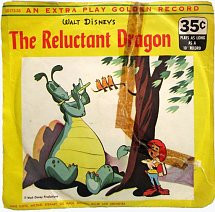 Lyric changes:
Lyric changes:
This version contains the most drastic lyric changes, and though the lyrics are still credited to Wolcott, Ed Penner, and T. Hee, it’s a mystery why this occurred. It could simply be the original lyrics were considered outdated, or some other unknown issue arose, and a rewrite became necessary. Regardless, the queerness that was prevalent in the original version is now scrubbed away entirely and presents a much more sanitized version of the character.
D1 – I’m THE RELUCTANT DRAGON, you see, that’s me
A perfectly harmless Dragon, who likes to write poetry
I’m probably the sweetest Dragon, that’s me, you see
I hate to fight, don’t give a hoot
I’d rather sit and play my flute
Wow! I’m delightful
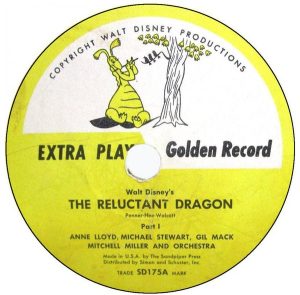 D2 – I’m a delightful Dragon, you know it so
D2 – I’m a delightful Dragon, you know it so
A really delightful Dragon, and not a single place to go
But I’m a contented Dragon
I’ll stay right here
And sing to the bird and buzz with the bee
And at four o’clock I’ll sip my tea
Wow! I’m romantic!
Spoken –
N1 – Well Dragon old boy, it’s been jolly meeting you
I’d better leave and tell everyone I couldn’t find a mean old Dragon,
You’re much too nice to kill
Well, toodeloo
D3 – Toodeloo to you too!
Well, what do you know
He said I was the nicest Dragon (laughs)
Singing resumes –
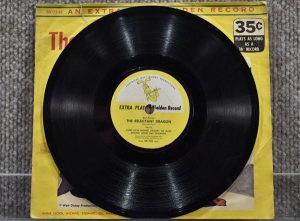 D4 – Oh I am the nicest Dragon
D4 – Oh I am the nicest Dragon
Said he to me
He said I’m the nicest Dragon
And I very modestly agree
I know I’m a lazy Dragon
I’m slow, you see.
I don’t blow fire through my nose
I’d rather sit and twiddle my toes!
Wow! I am lazy
D5- I’m delightful…
Romantic…
The nicest…
The laziest…
The craziest Dragon around
The narrator is removed from nearly the entire song, instead appearing briefly during a spoken section after D2.
What I can best describe as vocal warmups are sung by the dragon before and after D1.
Reluctant Dragon
Thurl Ravenscroft
All About Dragons (1966)
This version can be heard on the Disneyland Records album, All About Dragons. For those interested in more of the technical side and history of the album, I again recommend Ehbar’s article “Disney’s “The Reluctant Dragon” – on Records.” My minor addition about this recording is that eagle-eyed observers will notice the art of the dragon appears to include his original navel design—before the Code swooped in and demanded all traces of it be removed. Interestingly, there’s a The Reluctant Dragon poster of the dragon in the same pose, but with the navel detail conveniently obscured or removed.
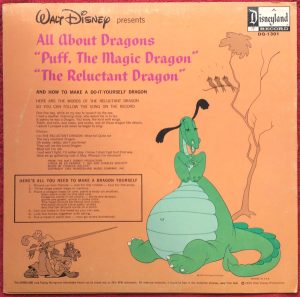 Compared to other versions of the song, this simplified arrangement does make more of an attempt at capturing a medieval flair reflective of the story’s original time period. While I initially suspected the string instrument was a mandolin, when I consulted with a string expert I know, he theorized it could be a bouzouki. Regardless, I can respect the attempt at trying a different musical direction for the song, though how memorable this choice ultimately is depends on the listener’s taste preferences.
Compared to other versions of the song, this simplified arrangement does make more of an attempt at capturing a medieval flair reflective of the story’s original time period. While I initially suspected the string instrument was a mandolin, when I consulted with a string expert I know, he theorized it could be a bouzouki. Regardless, I can respect the attempt at trying a different musical direction for the song, though how memorable this choice ultimately is depends on the listener’s taste preferences.
Anyone hoping Thurl Ravenscroft will put on an exaggerated falsetto while portraying the dragon will be greatly disappointed. Instead, he gives one of the rare portrayals of the dragon as a baritone. Where Ravenscroft really excels is in his dual role as both the narrator and the dragon. He distinguishes between the two characters wonderfully, both in register and characterization, and at times I would question if he truly was voicing both.
However, I’ll admit, despite being a fan of Ravenscroft, I’m a bit disappointed by this version. I’m more of a fan of faster songs, and this one is paced so slowly I couldn’t tell if the recording I listened to needed to be sped up. Ravenscroft’s articulation also could have been clearer at times, especially when he utters “whoops.” Sometimes the emphasis lands more strongly on the “oops” than the “wh” part, making it difficult in certain verses to distinguish whether he is saying “whoops” or “oops.”
Lyric changes:
Besides an additional word here and there in the narrator’s verses, there are no major lyric changes.
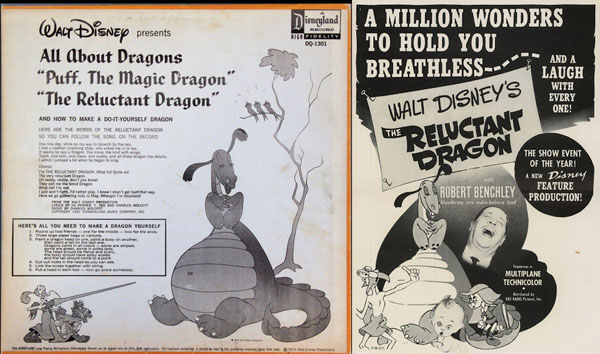
Medley: The Reluctant Dragon / Never Smile at a Crocodile
The Richard Wolfe Children’s Chorus
The Ballad of Smokey the Bear and Other Favorite Animal Songs (1969)
I have a confession to make. While I like children’s records, I don’t often like listening to children’s vocals. So already, this medley is not for me. In addition, those expecting to hear a balance of both songs in this medley will be greatly disappointed, as this version contains much, much more of the second song, “Never Smile at a Crocodile.” On the other hand, at least there isn’t much for me to analyze.
Personally, this version is one of the most forgettable out of all the songs I’m covering and will likely be the only source of interest for the true “The Reluctant Dragon” cover completionists out there. But hey, at least it’s a quick listen!
Lyric changes:
This version contains none of the narrator’s verses and only covers D1, with no changes to the verse.
The Reluctant Dragon (excerpt)
Marlene Bellissimo (2020)
Moving now to the 21st century, this song is currently the only recording I am examining that is covered by a known queer artist. Unfortunately, Marlene confirmed with me that she never recorded a full version, but I still consider this excerpt a wonderful addition to “The Reluctant Dragon” song canon. Of particular interest is that this cover is one of the most simplified versions of the song, with only a piano and Marlene’s vocals. It was a nice surprise to hear such a simplistic accompaniment, which, given Marlene’s strengths as an arranger, works in this cover’s favor. In this version, the narrator has been removed entirely, and Marlene sings solely from the dragon’s perspective. By only singing the dragon’s verses, it refocuses the song and allows a reclaiming of the narrative.
This version can be heard at the end of her video essay, “Disney’s Most Stereotypically Queer Film,” which analyzes the dragon character in depth. While her video on The Reluctant Dragon is a few years old, it was the first time I learned about the dragon being analyzed through a queer lens. I also consider her research, which is cited in the video’s description, a fantastic springboard for others interested in learning more about this topic. If one would like to support Marlene, you can subscribe to her YouTube channel Avelo, follow her on Instagram avelospricht, and support her on Patreon.
Lyric changes:
This excerpt only covers D1 and D2, and the narrator role is removed entirely.
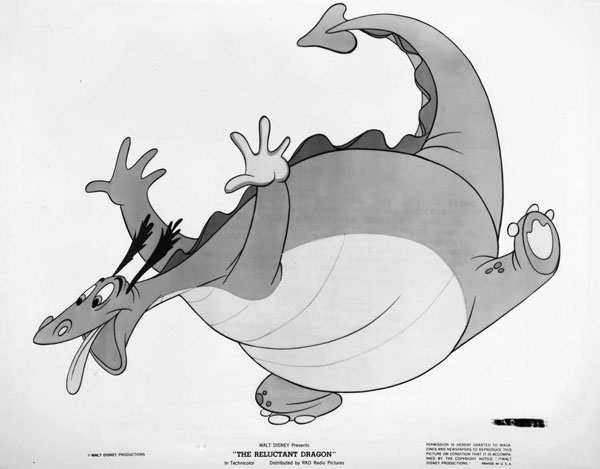
This concludes part 4 on The Reluctant Dragon songs released throughout the 20th and 21st century. Upcoming articles in this series will focus on other animated adaptations of The Reluctant Dragon story, and the Reluctant Dragon’s later appearances in Disney media.